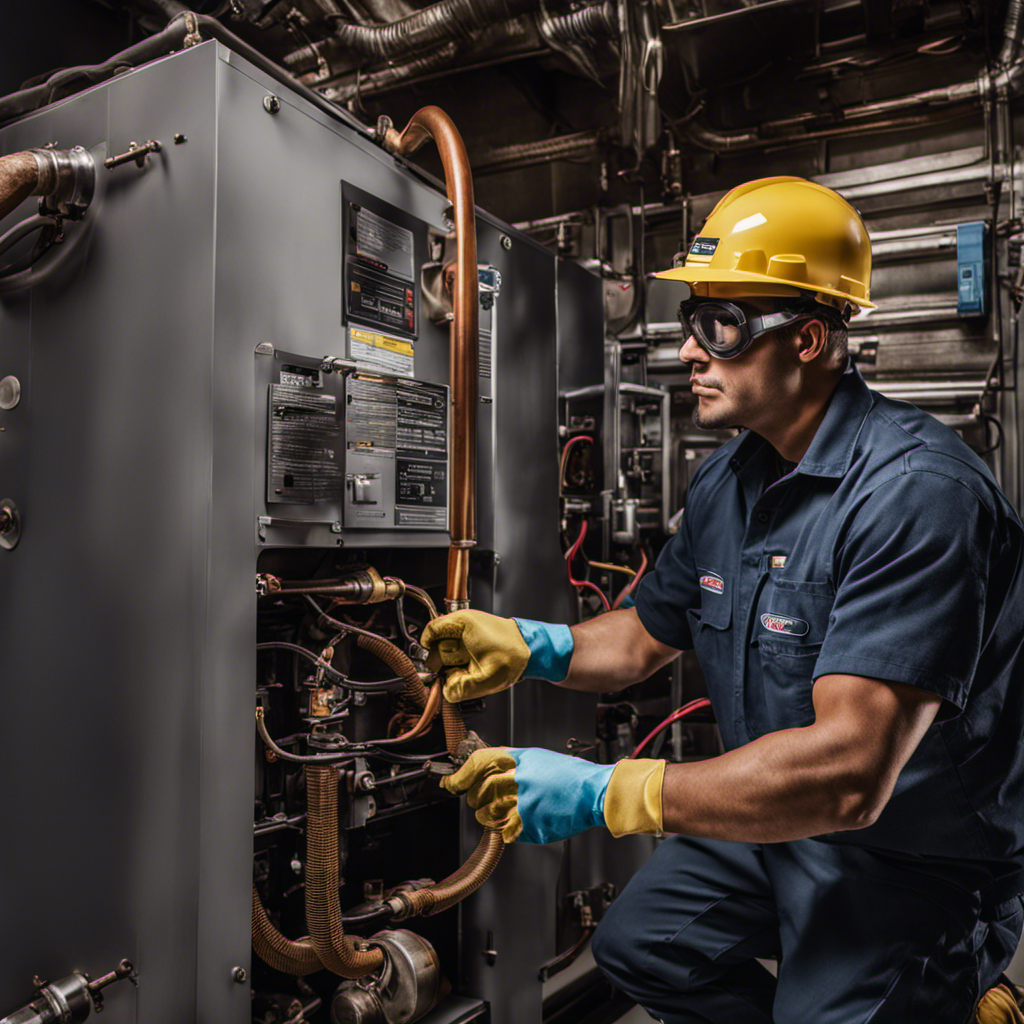In the pursuit of providing optimal service, it is essential to prioritize safety when starting up and shutting down furnaces. This article aims to outline the necessary precautions one must take during these crucial processes.
By adhering to the recommended safety measures, individuals can ensure the well-being of both themselves and those they serve. From preparing the furnace for startup to implementing proper shutdown procedures, this article offers valuable insights to maintain furnace efficiency and safety.
Key Takeaways
- Follow proper safety measures and emergency protocols to minimize accidents and injuries
- Thoroughly inspect furnace components before startup and address any issues through troubleshooting
- Carefully follow manufacturer’s instructions and safety measures for ignition
- Regularly monitor furnace temperature, adjust fuel input, and schedule annual professional maintenance to maintain efficiency and safety
Safety Measures for Starting up Furnaces
Always ensure that proper safety measures are followed when starting up furnaces to minimize the risk of accidents or injuries. Preventing accidents should be the priority when dealing with such potentially hazardous equipment.
Before starting the furnace, it is crucial to conduct a thorough inspection to ensure everything is in proper working order. This includes checking for any leaks, loose connections, or damaged components.
It is also important to have a clear understanding of the emergency protocols in case of any unforeseen circumstances. This includes knowing the location of emergency shut-off switches, fire extinguishers, and emergency exits.
Additionally, proper training should be provided to all personnel involved in operating the furnace, ensuring they are aware of the potential risks and the necessary safety precautions to take.
Preparing the Furnace for Startup
Before startup, the furnace’s components should undergo a thorough inspection to ensure their proper functioning. This step is crucial to prevent any potential issues or malfunctions during the preheating process.
It is important to check the condition of the burners, ignition system, and control panel, making sure they are clean and in good working order.
Additionally, the fuel source selection is a critical consideration. The appropriate fuel source must be chosen based on the specific requirements of the furnace and the available options. Factors such as efficiency, cost, and environmental impact should be taken into account.
Key Steps to Safely Ignite the Furnace
During the ignition process, it is essential to carefully follow the manufacturer’s instructions and take into account the specific safety measures for igniting the furnace.
Safety precautions should always be a top priority to ensure the well-being of both the service provider and the customer.
Before igniting the furnace, it is crucial to inspect the area around the furnace for any flammable materials or obstructions. Make sure to open all air vents and ensure proper ventilation to prevent the buildup of dangerous gases.
Additionally, it is important to wear appropriate personal protective equipment, such as gloves and goggles, to protect against potential hazards.
Before starting the ignition, double-check that all fuel lines and connections are secure to avoid any leaks.
Monitoring and Adjusting Furnace Settings
Regularly monitoring and adjusting furnace settings is essential for maintaining optimal performance and energy efficiency. By monitoring the furnace temperature, you can ensure that it remains within the desired range for efficient operation. This allows you to identify any potential issues or malfunctions early on, preventing costly repairs and downtime.
In addition, adjusting the fuel input based on the furnace temperature can help optimize combustion and minimize energy waste. This involves carefully calibrating the fuel flow to match the heat demand of the furnace. By doing so, you can achieve the desired temperature while minimizing fuel consumption.
Regularly monitoring and adjusting furnace settings not only ensures the efficient operation of the furnace but also helps to reduce energy costs and environmental impact.
Proper Shutdown Procedures for Furnaces
To ensure the safe and efficient shutdown of furnaces, it is crucial to follow proper procedures and coordinate with maintenance personnel. Proper shutdown procedures for furnaces help prevent any potential hazards and ensure the longevity of the equipment.
Before initiating the shutdown, it is essential to check for any signs of malfunction or unusual operation. This is where furnace troubleshooting comes into play. By identifying and addressing any issues beforehand, you can prevent further damage and ensure a smoother shutdown process.
Additionally, regular furnace maintenance is vital to keep the equipment in optimal condition and minimize the chances of unexpected shutdowns. By following proper shutdown procedures and conducting regular maintenance, you can extend the lifespan of your furnace and avoid any unnecessary disruptions.
Tips for Maintaining Furnace Efficiency and Safety
Maintaining furnace efficiency and safety requires implementing proper maintenance practices and regularly inspecting the equipment. By taking proactive steps, homeowners and service professionals can ensure that furnaces operate at peak performance while reducing energy consumption.
One key tip for maintaining furnace performance is to clean or replace the air filters regularly. Dirty filters can restrict airflow and force the furnace to work harder, resulting in higher energy usage.
Additionally, it is important to schedule annual professional maintenance to check for any potential issues and ensure that all components are functioning properly. This can help identify and address any problems before they escalate, improving both efficiency and safety.
Lastly, homeowners should also consider installing a programmable thermostat, which allows for more precise temperature control and can further reduce energy consumption.
Frequently Asked Questions
Can I Use Any Type of Fuel to Start up My Furnace?
When starting up a furnace, it is important to consider the type of fuel being used. While alternative fuels may be an option, safety precautions must be taken to ensure proper handling and prevent potential risks.
How Often Should I Monitor and Adjust Furnace Settings During Operation?
Regular monitoring and adjustment of furnace settings during operation is crucial for optimal performance and efficiency. Implementing furnace maintenance tips, such as cleaning and inspecting components, ensures safe and reliable operation while maximizing energy savings.
Is It Necessary to Shut Down the Furnace Completely After Each Use?
Shutting down a furnace properly and following proper startup procedures are essential to ensure safety and efficiency. It is necessary to take precautions when starting up and shutting down furnaces to prevent accidents and maintain optimal performance.
What Are Some Common Signs of a Malfunctioning Furnace That Should Be Addressed Immediately?
Common signs of a malfunctioning furnace that should be addressed immediately include strange noises, inconsistent heating, frequent cycling on and off, and unusual smells. Troubleshooting steps should be taken to identify common causes and ensure proper functioning.
Are There Any Specific Maintenance Tasks That Should Be Performed Regularly to Ensure Furnace Efficiency and Safety?
Regular furnace maintenance is crucial for ensuring efficiency and safety. Professional inspections should be conducted regularly to identify any potential issues and address them promptly. Prioritizing maintenance will help prevent costly repairs and extend the lifespan of the furnace.


